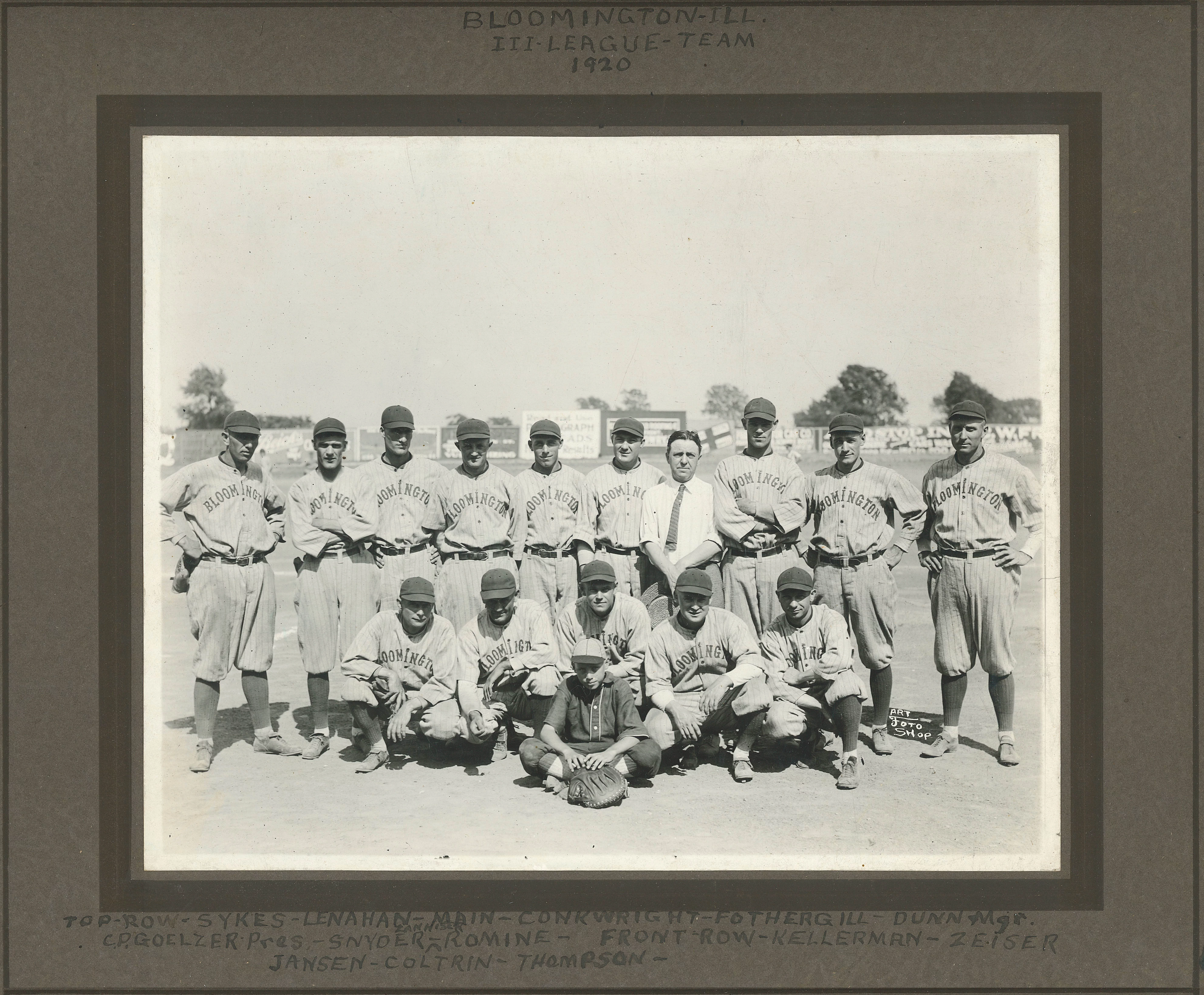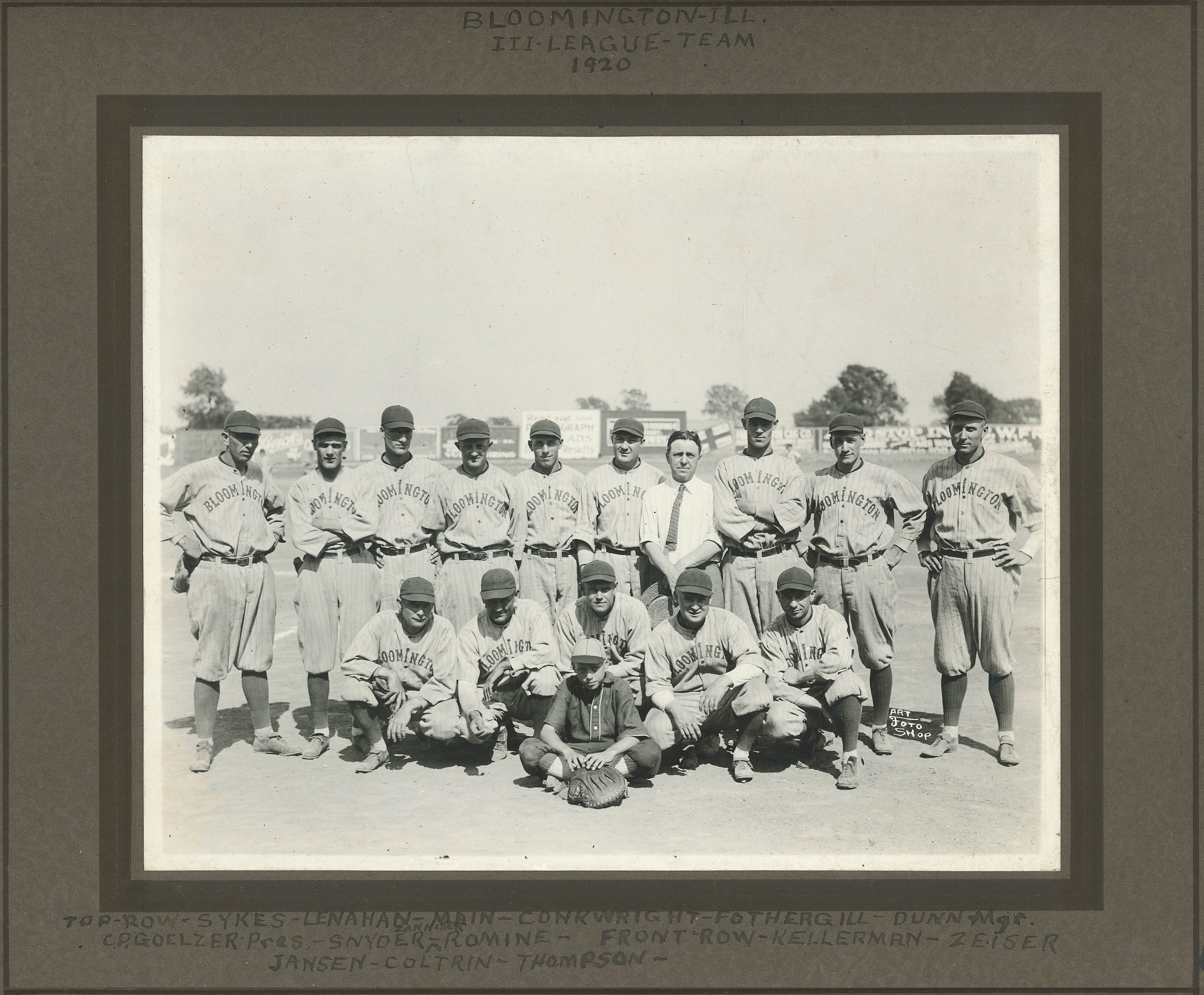A single photograph can open a door into a lost world. This Bloomington Bloomers team photo, for instance, taken at Fans Field during the 1920 season, tells us a lot about the National Pastime in the early decades of the 20th century—the game itself, the men who played it, and the nation that embraced it.
Seven of the 14 Bloomers shown here played in the Major Leagues, though most didn’t stay long—having, it’s said, little more than the proverbial “cup of coffee” when they got there.
Bloomington was once part of the Illinois-Indiana-Iowa League, an established, well-respected minor league which over the years was home to some of the game’s greatest—hall of famers Mordecai “Three Finger” Brown (who first played for Terre Haute in 1901), Carl Hubbell (Decatur, 1927), Hank Greenberg (Evansville, 1931), Burleigh “Old Stubble Beard” Grimes (Bloomington, pitcher-manager, 1935), and a surprisingly large number of others.
In 1920, the Bloomington Bloomers captured their second consecutive Three-I League pennant with an 82-57 record. The eight-team league that season featured the Evansville Evas, Cedar Rapids Rabbits, Moline Plowboys, Peoria Tractors, Rock Island Islanders, Rockford Rox and the Terre Haute Browns.
Looking at this photo, the man in the white shirt and tie is Charles P. “Charlie” Goelzer (1868-1927), president of the Bloomington (Baseball) Fan Association, the organization which owned and operated the minor league club. Coming from Appleton, Wisc., Goelzer settled in Bloomington, marrying Anna Holland and becoming the manager of the clothing department at My Store, a bustling downtown retailer. In 1924, he opened his own clothing store with son Norval.
This photograph and many other treasures recently came to the McLean County Museum of History from a great-granddaughter of Goelzer's living in Michigan. She was in the Twin Cities in early September for an interment service at a local cemetery, which proved an opportune time to donate a collection of Goelzer and Karr family photographs and papers to the history museum.
Other fascinating items in this collection include a set of letters of recommendation for Rae Gertrude Goelzer (1891-1972), Charlie and Ann’s daughter, who was an Illinois State Normal University graduate applying for a teaching position in 1910. Rae married Lee J. Karr in 1912, who was born and raised on a farm in Shirley. Also donated to the museum were Karr family rationing stamps dating to World War II, and other equally fascinating items.
This 1920 team photo includes seven major leaguers, but only Robert Roy Fothergill (back row, fifth from left) enjoyed sustained success on the game’s biggest stage. The 22-year-old rookie from Massillon, OH, led the 1920 Three Eye season in hits, runs batted in (RBIs) and batting average. He would go on to play 12 seasons in the majors, with most of that spent as a key reserve outfielder with the Ty Cobb-led Detroit Tigers. Fothergill sure looks plenty fit and trim here, but during his big league days he packed on the pounds, earning various nicknames, including “Rob Roy the Tiger Fat Boy.” A consummate showman, “Rotund Robert” was known for his swan dive slide into the bases.
Such stories make the National Pastime a national treasure, but we cannot forget that baseball carries not only the blessings of the American experience, but its curses as well. In this team photo, for instance, there are no people of color because Major League Baseball and the affiliated minor leagues excluded Black ballplayers. The “color line” would not begin to crumble until 1947 when Jackie Robinson debuted with the Brooklyn Dodgers.
Back in August 1920, the Bloomington Bloomers dealt Fothergill and right-handed pitcher Allen Conkwright (left of Fothergill) to Detroit. The 23-year-old Conkwright, who went 24-7 with the Bloomers in 1920, ended up starting 3 games for the Tigers late that season. Sadly, he never made it back to the majors.
Sac City, Ia. native Paul Zahniser (back row, second on the right) was a key member of Bloomington’s 1919 and 1920 championship teams. The righthander had been on loan to Bloomington in a gentlemen’s agreement with the Toledo Mud Hens of the American Association. He then spent the next two years winning 42 games for Memphis of the Southern Association. From there it was four seasons in the American League—two apiece with Washington and Boston. He struggled, however, going 25-47 in four years—losing nearly twice as many games as won. Zahniser even led the A.L. in pitching losses with 18 in 1926, his last season with Red Sox.
There were also four veterans on the Bloomers 1920 roster who had played in the big leagues earlier in their careers.
Bloomers Manager Joe Dunn (left of Goelzer)—35 years old during the 1920 season—appeared in 30 games over 2 seasons (1908-1909) for the National League Brooklyn Superbas (later renamed the Dodgers). Dunn’s Major League Baseball career was short-lived, but he enjoyed success as a minor league skipper.
Pitcher Matt Zieser (first row, second from left) finished the 1920 season with a 19-10 record. The 31-year-old righthander (the name is misspelled in the photo), though, was nearing the end of his playing career, which earlier included appearing in 2 games for the 1914 Boston Red Sox—a “sip” of coffee, you might call it.
Although the middle figure in the first row is identified as “Jansen,” it’s almost certain that the ballplayer is Heinie Jantzen, the Bloomers’ 30-year-old right fielder. Bloomington was the last stop on Jantzen’s professional baseball career, which included playing in 31 games for the 1912 American League St. Louis Browns.
Early in playing career, outfielder Shag Thompson (front row, far right) appeared in 48 games over 3 seasons (1914-1916) for the American League Philadelphia Athletics. He never made it back to the big leagues, and instead spent a decade toiling in relative anonymity in the minors.
In many ways, the story of baseball is as much the story of James Alfred “Shag” Thompson as it is the story of one George Herman “Babe” Ruth Jr.

